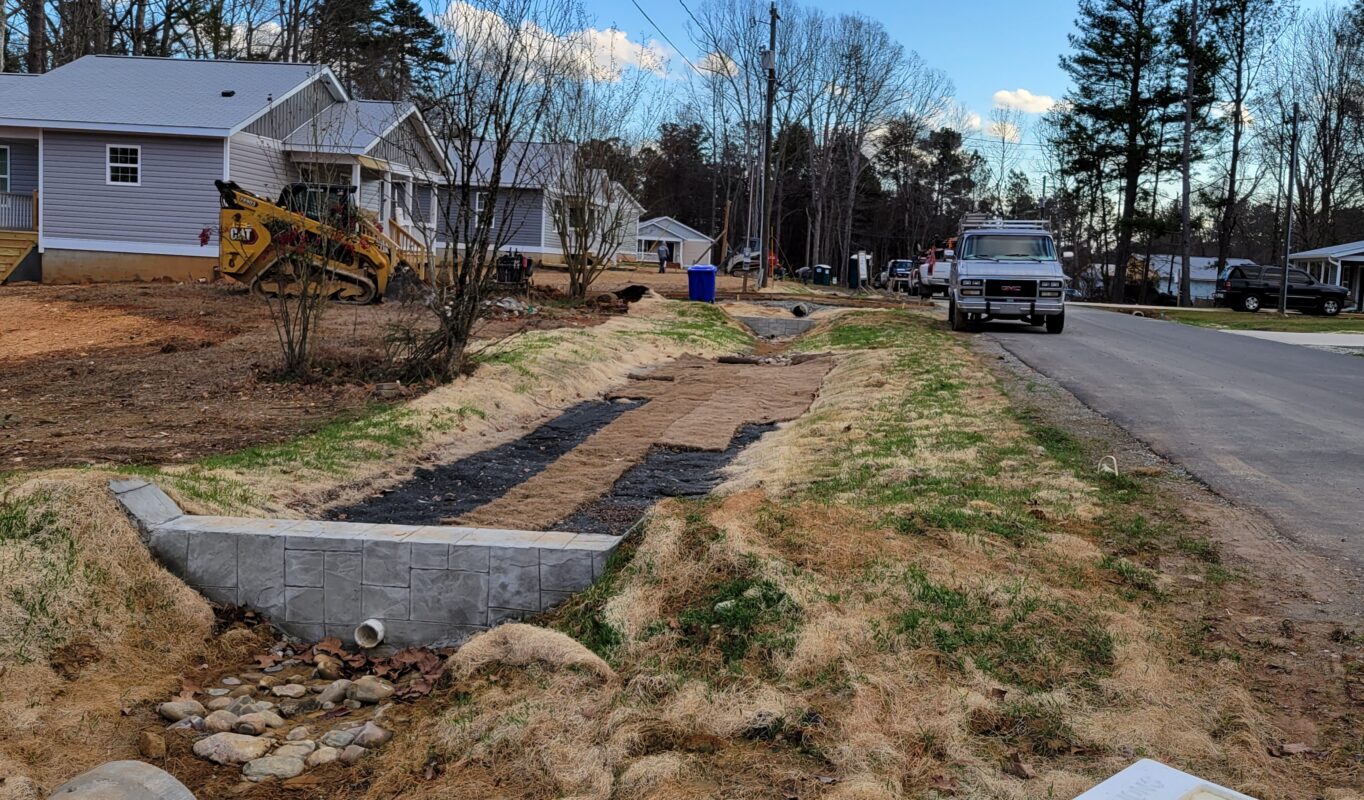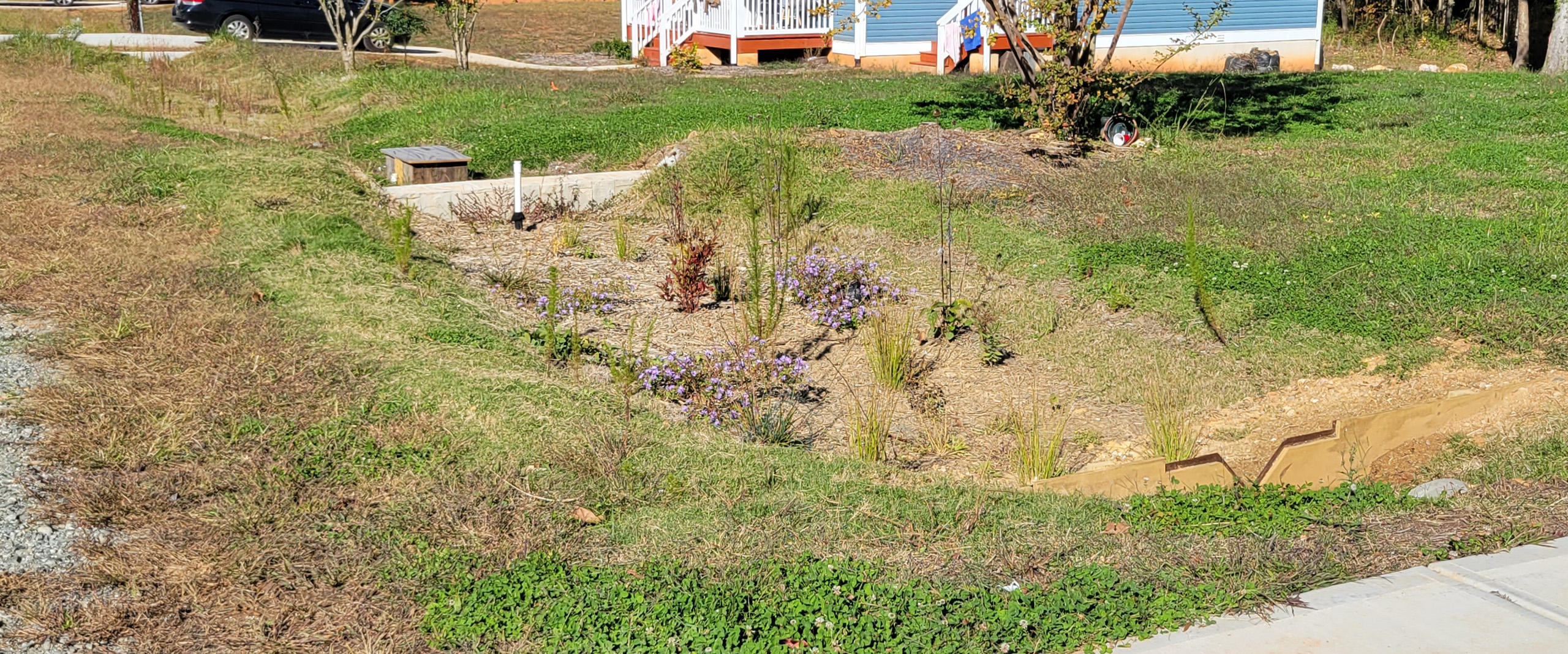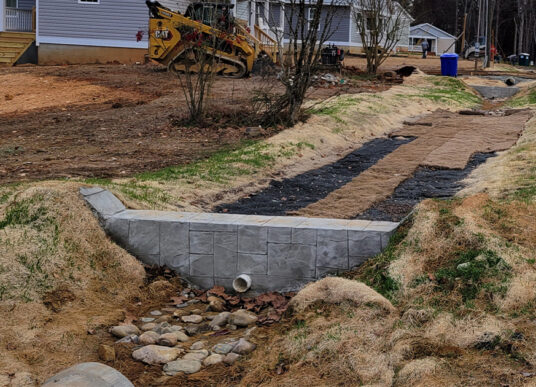Situated on the northwest side of Hillsborough, North Carolina, Odie Street is home to a diverse and historically underserved community.
For years, the neighborhood faced poor conditions including broken housing, incised ditches, overgrown invasive vegetation, and, at times, a flooded road. As part of a collaborative and community-driven process, a plan was put in place to revitalize the area and achieve social, economic, and environmental gains to benefit the community.
In 2016, Odie Street began undergoing rehabilitation efforts by the Town of Hillsborough, the Piedmont Conservation Council (PCC), and the Habitat for Humanity, as well as other non-profit stakeholders, to redevelop 22 homes within the neighborhood. Simultaneously, the Town displayed visionary thinking by not only planning to regrade the drainage ditches and pave the road but also recognizing the opportunity to integrate green stormwater infrastructure (GSI) as a valuable retrofit component. To accomplish this goal, the Town teamed with PCC to secure a North Carolina Environmental Enhancement Grant that funded the design and construction of GSI features. Once awarded, KCI was tasked with planning and designing the features within the Town’s right-of-way to help reduce flooding and provide water quality improvements to the residents.
Throughout the project, it was imperative that the Odie Street homeowners be actively involved in the decisions that would impact their community. KCI led consistent public outreach efforts, giving residents direct involvement in key components surrounding the design and implementation of the infrastructure. Among the homeowners, a subset spoke English as a second language. To facilitate optimal communication and understanding, our team worked with translators to ensure that our efforts would adequately convey information and the importance of the project. All public outreach materials were designed for English and Spanish speakers, and another specifically for speakers of Karen, a language originating from Burma.
 Workshops, public meetings, and informational handouts cultivated acceptance of the new GSI features being constructed within the project site.
Workshops, public meetings, and informational handouts cultivated acceptance of the new GSI features being constructed within the project site.Through design workshops, residents were able to learn about bioswales and treatment swales, a sustainable method for treating stormwater runoff through vegetation, and actively contribute their insights regarding these GSI features. To accommodate homeowners who were unable to attend these workshops, personalized one-on-one meetings were conducted with the partners, offering an in-depth explanation of the project and the opportunity to gather their individual input. The feedback garnered was seamlessly integrated into the project’s plans and acted as a guiding influence throughout the construction phase.
 KCI staff conducted public meetings with residents highlighting the benefits of bioswales and seeking design input.
KCI staff conducted public meetings with residents highlighting the benefits of bioswales and seeking design input.Considering the valuable input from residents, KCI developed the stormwater design, which consisted of linear bioswales and treatment swales with aesthetic check dams, to fit in with the look and feel of the newly redeveloped neighborhood. The bioswales involved the use of specialized soil media and vegetation. They temporarily retain stormwater, encourage infiltration, and facilitate the removal of contaminants from runoff through processes such as absorption, evaporation, and plant uptake. This technique provides several benefits to the area including improved water quality and urban wildlife habitats, while reducing flooding and radiation of heat from urban landscapes.
The bioswales for the Odie Street project also utilized an innovative technique: an underdrain with an upturned elbow, a combination that creates a frequently saturated anerobic zone that reduces soil oxygen levels and removes more nitrogen and phosphorous from the runoff than traditional stormwater systems. This innovation was particularly important along Odie Street as the location is near a stream that flows to local rivers and lakes, where nutrient pollution could cause harmful algal blooms. KCI also worked with the NC State University’s Biological and Agricultural Engineering Department on the underdrain design to integrate access points for monitoring bioswale outflows in support of ongoing research on pollutant removal efficiencies.
 After installing unique bioswale and underdrain infrastructure, KCI coordinated with biological researchers to monitor nitrogen and phosphorous levels in the stormwater outflow.
After installing unique bioswale and underdrain infrastructure, KCI coordinated with biological researchers to monitor nitrogen and phosphorous levels in the stormwater outflow.“Incorporating GSI in low-to-moderate income neighborhoods is an important step towards creating more sustainable and resilient communities by reducing stormwater runoff and improving the overall environmental health and aesthetics.”
Leah Young, PE, Regional Practice Leader
During the design phase, KCI successfully navigated and resolved distinct challenges arising from operating within a restricted right-of-way, navigating around existing driveways and utilities, and adapting to an active construction zone, where Habitat for Humanity’s home rehabilitation work was ongoing simultaneously with the design and construction of the bioswales. As the home construction efforts continued, adjustments were made to some of the rainwater basins to accommodate new driveways and property features. The design of the swales also had to consider grading limitations and size restrictions imposed by nearby driveways, utility pipelines, and a stream running through the project site. Through careful coordination, the project team worked through these constraints, innovatively addressed these limitations, optimized the use of available space, maximized water quality treatment and integrated elements to preserve the community’s visual identity.
 Adapting to the evolving landscape, our team creatively redesigned the rainwater basins to overcome both grading limits and size restrictions.
Adapting to the evolving landscape, our team creatively redesigned the rainwater basins to overcome both grading limits and size restrictions. Once design was finished, KCI’s engineers prepared final construction plans, specifications, and cost estimates for the Town of Hillsborough. Throughout the final phase, our team provided construction management services and performed as-built surveys.
The completion of the Odie Street rehabilitation project serves as a template for similar communities to develop their own strategies for engaging the residents, prioritizing equity, and funding sustainable infrastructure. As a result of the project’s success, the American Public Works Association North Carolina Chapter honored the endeavor with the Stormwater Green Infrastructure Project of the Year Award and the American Council of Engineering Companies of North Carolina awarded KCI with its Engineering Excellence Award in the Water & Environment category.
With improvements now finalized, the community can experience a more sustainable and resilient atmosphere through reduced stormwater runoff and enhanced environmental health and aesthetics.

